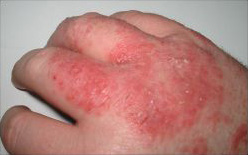
Eczema (atopic dermatitis) is a chronic health problem that affects people of all ages. It is a non-contagious, inherited skin condition causing patches of skin to become red, dry and itchy. Eczema becomes particularly uncomfortable if the skin flares up, worsens and becomes infected. Individuals who suffer eczema have skin that doesn’t retain moisture well, causing their skin to dry out easily and become open to allergens and irritants. Allergens and irritants trigger the skin to release chemicals, creating an itch that can be mild to severe. Scratching causes more chemicals to be released, making the skin feel itchier. This scratch and itch cycle creates persistent discomfort, disrupted sleep and will affect an individual’s quality of life.
It is not well understood why some people develop eczema and others don’t, however, it is common for people with eczema to experience other allergies. This suggests that inherited (genetic) factors increase the tendency to develop more than one type of eczema.
There are several different types of eczema – atopic dermatitis and occupational contact dermatitis. The most common type seen in farmers and ag workers is occupational contact dermatitis (OCD).
Occupational Contact Dermatitis
Occupational contact dermatitis (OCD) is a skin condition caused by work-related exposures. Occupational contact dermatitis is a rash which develops as a result of exposure to specific physical exposures and irritating or allergic substances – referred to triggering agents. Constant exposure to triggering agents will damage the natural barrier function of the skin. When the protective barrier of the skin is lost, eczema will develop and cause either contact irritant or allergic dermatitis. In either instance, a rash will develop (most commonly on the hands, arms and face) and skin will become red inflamed and itchy. In determining the diagnosis between the two types of dermatitis the difference, presentation and history of the rash is considered.
- Irritant Contact Dermatitis (ICD) – tends to present a rash that is confined to the area where the trigger touches the skin and develops immediately, whereas
- Allergic Contact Dermatitis (ACD), the rash is more likely to be widespread on the skin and take a day or so to develop.
Triggering agents for occupational contact dermatitis in farmers and ag workers include:
- Solvents and cleaners
- Disinfectants
- Pesticides & fertilisers
- Foods
- Plants
- Dust
Farmers and ag workers can prevent occupational contact dermatitis using the following control measures:
- Eliminate or prevent exposure to triggering agents where possible.
- Be compliant and wear appropriate personal protective equipment to protect the skin from triggering agents.
- Ensure you choose a suitable glove for the best hand protection.
- Avoid soap and bubbly products which damage and dry out the skin.
- Use water-based moisturizers after washing hands and oil-based moisturizers for extremely dry skin.
- Cover cracks and open sores with an appropriated dressing.
To find out more information about eczema visit Better Health Channel
Fast facts:
- Occupational contact dermatitis is an uncomfortable itchy skin condition, common among farmers.
- Avoiding known triggering agents and irritants is the most effective way to prevent eczema.
- Wearing gloves and protecting skin when handling chemicals, cleaners and fertilisers will help prevent eczema.
- Treat eczema flare ups immediately.
- Manage the itch and prevent infection.
References used for this topic
More information:
Eczema Association of Australasia
Facts about Eczema
Research & reviews:
Australasian Journal of Dermatology
Occupational contact dermatitis among New Zealand farmers
Australasian Journal of Dermatology
Irritant contact dermatitis: A review
International Archives of Occupational and Environmental Health
Tertiary individual prevention of occupational skin diseases: a decade’s experience with recalcitrant occupational dermatitis
Journal of Clinical Investigations
New insight into atopic dermatitis
Safe Work Australia
Occupational Contact Dermatitis in Australia 2006
|
|